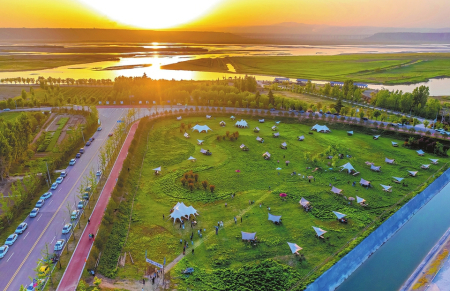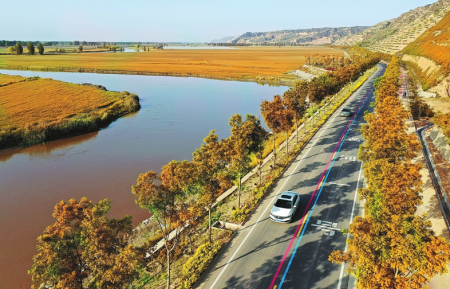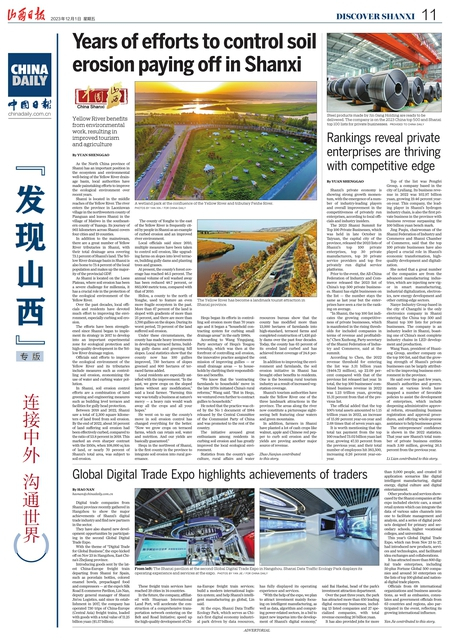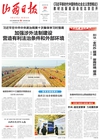Years of efforts to control soil erosion paying off in Shanxi

A wetland park at the confluence of the Yellow River and tributary Fenhe River.Photos by Yan Xin / for China Daily

The Yellow River has become a landmark tourist attraction in Shanxi province.
The Yellow River has become a landmark tourist attraction in Shanxi province.
As the North China province of Shanxi has an important position in the ecosystem and environmental well-being of the Yellow River drainage basin, local authorities have made painstaking efforts to improve the ecological environment over recent years.
Shanxi is located in the middle reaches of the Yellow River. The river enters the province in Laoniuwan village in the northwestern county of Pianguan and leaves Shanxi in the village of Matiwo in the southeastern county of Yuanqu. Its journey of 965 kilometers across Shanxi covers four cities and 19 counties.
In addition to the mainstream, there are a great number of Yellow River tributaries in Shanxi, with their total drainage area covering 73.1 percent of Shanxi's land. The Yellow River drainage basin in Shanxi is also home to 73.4 percent of the local population and makes up the majority of the provincial GDP.
As Shanxi is located on the Loess Plateau, where soil erosion has been a severe challenge for millennia, it has a crucial role in the protection of the ecological environment of the Yellow River.
Over the past decades, local officials and residents have devoted much effort to improving the environment, especially curbing soil erosion.
The efforts have been strengthened since Shanxi began to implement its strategy in 2017 to develop into an important experimental zone for ecological protection and high-quality development in the Yellow River drainage region.
Officials said efforts to improve the ecological environment of the Yellow River and its tributaries include measures such as controlling soil erosion, economizing the use of water and curbing water pollution.
In Shanxi, soil erosion control efforts are a combination of land greening and engineering measures such as building level terraces and facilities for gully head protection.
Between 2018 and 2022, Shanxi saw a total of 2,300 square kilometers of land freed from soil erosion. By the end of 2022, about 56 percent of land suffering soil erosion had been effectively curbed, compared to the ratio of 53.8 percent in 2018. This marked an even sharper contrast with the 1950s, when 108,000 sq km of land, or nearly 70 percent of Shanxi's total area, was subject to soil erosion.
The county of Yonghe to the east of the Yellow River is frequently cited by people in Shanxi as an example of curbed erosion and an improved river environment.
Local officials said since 2010, multiple measures have been taken to control soil erosion, like upgrading farms on slopes into level terraces, building gully dams and planting trees and grasses.
At present, the county's forest coverage has reached 46.5 percent. The annual volume of soil washed away has been reduced 48.7 percent, or 883,000 metric tons, compared with that of 2010.
Shilou, a county to the north of Yonghe, used to feature an even more fragile ecosystem in the past. More than 67 percent of the land is sloped with gradients of more than 25 percent, and there are more than 5,700 gullies on the slopes. During its worst period, 73 percent of the land suffered soil erosion.
Under these circumstances, the county has made heavy investments in developing terraced farms, building gully dams and greening hill slopes. Local statistics show that the county now has 100 gullies improved, 730 hectares of slopes greened and 800 hectares of terraced farms added.
Local residents are especially satisfied with the improvement. "In the past, we grew crops on the sloped farms without any modification," said a local farmer. "Farming this way was totally a business at nature's mercy — a heavy rain would wash away all the crops and all your hopes."
He went on to say the county's move in soil erosion control has changed everything for the better. "Now we grow crops on terraced farms, which can retain soil, water and nutrition. And our yields are basically guaranteed."
Hequ in the northwest of Shanxi, is the first county in the province to integrate soil erosion into rural governance.
Hequ began its efforts in controlling soil erosion more than 70 years ago and it began a "household contracting system for curbing small drainage areas" in the early 1980s.
According to Wang Yingqiang, Party secretary of Hequ's Tougou township, which was then at the forefront of controlling soil erosion, the innovative practice assigned the mission of improving gullies — or small drainage areas — to households by clarifying their responsibilities and benefits.
"We know that the 'contracting farmlands to households' move in the late 1970s initiated China's rural reforms," Wang said. "But in Hequ, we ventured even further to contract gullies to households."
He noted that the practice was cited by the No 1 document of 1984 released by the Central Committee of the Communist Party of China and was promoted to the rest of the country.
The initiative aroused great enthusiasm among residents in curbing soil erosion and has greatly improved the local ecological environment.
Statistics from the county's agriculture, rural affairs and water resources bureau show that the county has modified more than 13,000 hectares of farmlands into high-standard, terraced farms and completed construction of 1,426 gully dams over the past four decades. Today, the county has 65 percent of its eroded land curbed and has achieved forest coverage of 24.8 percent.
In addition to improving the environment and farmlands, the soil erosion initiative in Shanxi has brought other benefits to residents. One is the booming rural tourism industry as a result of increased vegetation coverage.
Shanxi's tourism authorities have made the Yellow River one of the three landmark attractions in the province. The areas along the river now constitute a picturesque sightseeing belt featuring clear waters and green mountains.
In addition, farmers in Shanxi have planted a lot of cash crops like walnut, apple and Chinese red pepper to curb soil erosion and the yields are proving another major source of revenue.
Zhao Jianjun contributed to this story.
By Yuan Shenggao











